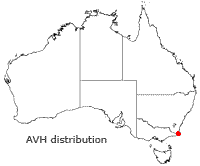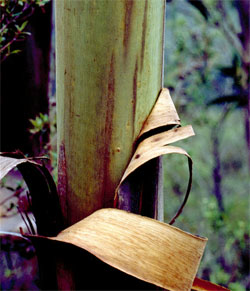Eucalyptus imlayensis
Imlay Mallee
Eucalyptus imlayensis Crisp & Brooker
 Eucalyptus imlayensis , or Imlay Mallee, is a member of the Myrtaceae family and exhibits the typical ‘mallee’ growth form with multiple stems originating from a lignotuber. The dense canopy is formed by thick, green and glossy leaves, 10-15 cm long, that are held slightly erect at the end of the branchlets. Stems are characterised by smooth bark shedding in ribbons. Freshly exposed bark shows an attractive green colour which subsequently weathers through orange-brown to grey. In the wild small, white flowers are produced during summer followed by fruiting in autumn. These attributes make E. imlayensis a striking garden feature and with a growth height of 7 metres it is particularly suited for smaller gardens.
Eucalyptus imlayensis , or Imlay Mallee, is a member of the Myrtaceae family and exhibits the typical ‘mallee’ growth form with multiple stems originating from a lignotuber. The dense canopy is formed by thick, green and glossy leaves, 10-15 cm long, that are held slightly erect at the end of the branchlets. Stems are characterised by smooth bark shedding in ribbons. Freshly exposed bark shows an attractive green colour which subsequently weathers through orange-brown to grey. In the wild small, white flowers are produced during summer followed by fruiting in autumn. These attributes make E. imlayensis a striking garden feature and with a growth height of 7 metres it is particularly suited for smaller gardens.
The only known population of Eucalyptus imlayensis occurs on Mt Imlay, part of Mt Imlay National Park, southeast New South Wales, where it grows on the eastern face of the mountain just below the summit at 850 metres altitude. The entire population consists of 60-80 mature individuals, a majority which is confined to an area of about 1 ha. The terrain is steep and rocky with a ground layer of mosses. Underneath the open eucalypt canopy the vegetation is dominated by closed heathland.
Eucalyptus imlayensis is best propagated from seed, either by direct seeding or in a pot. Trials to establish plants from cuttings have shown very limited success. Regardless of method, the seed is best placed on top of the soil and covered with a fine layer of mulch, leaf litter or sand to ensure the seeds are kept moist during germination. Seedlings may be planted out in spring and once established will require little maintenance. A significant advantage of growing E. imlayensis is that old or damaged stems may be pruned back to the base with new growth soon emerging from the lignotuber.
Restricted species distribution and decline in the number and health of individual plants, due to a lack of seedling recruitment and infrequent seed production, has led to E. imlayensis being listed as Endangered under the EPBC Act (1999) and Critically Endangered under the New South Wales Threatened Species Conservation Act (1995). Insect attack by leaf-eating scales further threatens the population while researchers are yet to determine the extent of disease resistance in E. imlayensis to Phytophthora cinnamomi, a soil-borne pathogen present in the national park which causes root-rot in many native plant species.
Unfortunately for the keen gardener, neither seeds nor seedlings are yet commercially available. Collecting seeds from the existing wild population requires a special license. However, these are not easily obtained. Hopefully, E. imlayensis will become commercially available but until it does, it can be enjoyed and admired at the Australian National Botanic Gardens in Canberra and the Royal Botanic Gardens in Sydney.
Text by Sofia Jonsson (2011 Student Botanical Intern)
Name Meaning: Eucalyptus imlayensisEucalyptus – from the Greek eu meaning well, and kalyptos meaning covered, alluding to the cap or lid which covers the stamens in bud. Imlayensis – imlay, from Mt Imlay where it was found, and ensis from the Latin meaning from. |
References
Australian Native Plant Society (1995) Eucalyptus, Corymbia and Angophora- propagation. Available at http://anpsa.org.au [Accessed 11 February 2011]
Crisp, M.D. & Brooker, M.I.H. (1980) Eucalyptus imlayensis, a New Species From a Mountain of South Coastal New South Wales. Telopea 2: 41-47.
Department of Environment and Climate Change (2008) State of Intent: 1: Infection of Native Plants by Phytophthora cinnamomi, Department of Environment and Climate Change, Sydney.
Department of Environment, Climate Change & Water (2009) Eucalyptus imlayensis- critically endangered species listing. Available at www. environment.nsw.gov.au [Accessed 11 February 2011]
Department of Sustainability, Environment, Water, Population and Communities (2010) Threatened Species & Ecological Communities- Eucalyptus imlayensis. Available at www.environment.gov.au [Accessed 11 February 2011]
Gledhill, D. (2002) The Names of Plants, 3 rd ed, Cambridge University Press, Cambridge.
James, E.A. & McDougall, K. L. (2007) Extent of clonality, genetic diversity and decline in the endangered mallee Eucalyptus imlayensis. Australian Journal of Botany 55: 548-553.
Ralph, M. (2009) Growing Australian Native Plants from Seed, 2 nd ed, Bushland Horticulture Publications, Bullarto.
Uwedo Hampshire, R. (Pers.comm.) Horticulturist, Australian National Botanic Gardens
![An Australian Government Initiative [logo]](/images/austgovt_brown_90px.gif)



